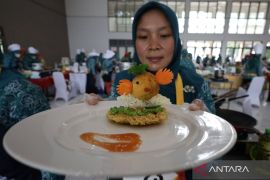Head of the Anthropometry Working Group of the Health Ministry, concurrently Pediatrician and Consultant for Nutrition & Metabolic Diseases, Prof. Dr Damayanti R. Sjarif, Sp.A (K) remarked that the fetus in the womb consumes the same food eaten by the mother. Likewise, at the time of breastfeeding, whatever the mother eats is taken up by the infant.
"You have formed the child's eating habits since pregnancy. When breastfed, the infant will be exposed to the food consumed by the mother. If the mother is not picky about food, the child will not become a picky eater," Prof. Sjarif recently remarked.
In fact, during pregnancy and breastfeeding, parents can introduce a variety of foods, so that in future, the child can develop a liking for any type of food that is offered.
"I pay attention to children with eating difficulties. I asked the mother if she had experienced vomiting during pregnancy? If so, then naturally (children become picky eaters) since when they were babies, they were not introduced to various types of food. If the mother introduces a variety of foods while the child is in the womb, it will not be fussy (in consuming food)," Prof. Sjarif stated.
When breastfed babies start consuming complementary foods (MPASI), they should also be provided the same foods consumed by their families. Prof. Damayanti does not recommend that babies be fed only one type of food, especially ingredients containing more flour.
"Give children the same food that the family members eat at home, but the texture of the food needs to be different. Mothers can provide complementary foods to breastfed babies. It is easy to make it. Simply mash it or blend it. They do not have to be cooked in a special way," she noted.
Consultant for Nutrition & Metabolic Diseases for Children at the Faculty of Medicine, University of Indonesia - Cipto Mangunkusumo Hospital (FKUI-RSCM) Dr Titis Prawitasari, Sp.A (K) had earlier expounded that complementary foods are best offered to children when the mother is unable to meet the child's milk requirements, especially when they reach six months of age.
Prawitasari remarked that mothers can provide sufficient milk to meet the needs of infants up to six months of age, and it is apparent from the indicators of good growth and development.
However, Prawitasari believes that if breast milk is no longer able to meet the child’s nutritional requirements before it reaches six months of age, then the mother can provide complementary foods.
If complementary foods are not provided after the child crosses six months of age, then it will experience a daily calorific shortage of about 200 calories.
An indication of the child being ready to receive nutrients apart from breast milk is its ability to hold its head up to support its chest whilst seated.
Another sign is the spontaneity of sticking its tongue out when there is less food in the mouth, also called extrusion.
Children are also considered ready to receive complementary foods when they exhibit enthusiasm on seeing food and are able to reach out to it and put it in the mouth. Related news: Ministry awaits recommendation to give COVID-19 vaccine to children
Related news: Online prostitution involving children must be dealt with seriously
Close
EDITED BY INE
Translator: Maria Cicilia, Katriana
Editor: Fardah Assegaf
Copyright © ANTARA 2021












